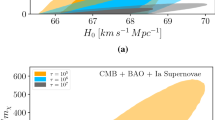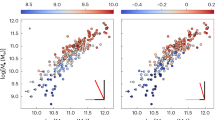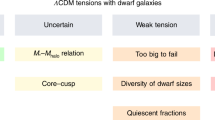Abstract
THERE are several clues to the history of the early Universe. The 3-K microwave background indicates that the Universe was highly isotropic when it was about a half million years old, and the abundance of 4He (also D, 3He and 7Li) indicates that nucleosynthesis was taking place when the Universe was about three minutes old. These two facts are strong evidence that the Universe began from a hot big bang1. In addition, Hawking, Ellis and Penrose have proved (within general relativity) that the existence of the 3-K radiation implies the Universe must have been singular in its past2,3. The existence and clustering of galaxies indicate there were some deviations from homogeneity in the early Universe. Perhaps the most curious fact about the Universe is that it is composed almost entirely of matter (the Universe contains negligible amounts of antimatter) and that the number of baryons per photon (∼baryon/entropy ratio) is between 10−10 and 10−8 (ref. 4). If baryon number is absolutely conserved, then it follows that the baryon number of the Universe must be viewed merely as an initial condition. Recent ideas in particle physics when applied to the early Universe may explain how an initially baryon-symmetrical (zero net baryon number) Universe could have evolved into one with net baryon number. Here, we will discuss these ideas and other interesting astrophysical implications.
This is a preview of subscription content, access via your institution
Access options
Subscribe to this journal
Receive 51 print issues and online access
$199.00 per year
only $3.90 per issue
Buy this article
- Purchase on Springer Link
- Instant access to full article PDF
Prices may be subject to local taxes which are calculated during checkout
Similar content being viewed by others
References
Schramm, D. N. & Wagoner, R. V. A. Rev. nucl. Sci. 27, 37–74 (1977).
Hawking, S. W. & Ellis, G. F. R. Astrophys. J. 152, 25–36 (1968).
Hawking, S. W. & Penrose, R. Proc. R. Soc. A314, 529–542 (1969).
Steigman, G. A. Rev. Astr. Astrophys. 14, 339–372 (1976).
Baltay, C. Tokyo Int. Conf. on High Energy Physics, August (1978).
Greenberg, O. W. A. Rev. nucl. Sci. 28, 327–386 (1978).
Appelquist, T., Barnett, R. M. & Lane, K. A. Rev. nucl. Sci. 28, 387–499 (1978).
Georgi, H. & Glashow, S. L. Phys. Rev. Lett. 32, 438–441 (1974).
Pati, J. C. & Salam, A. Phys. Rev. D8, 1240–1251 (1973).
Gürsey, F. & Sikivie, P. Phys. Rev. Lett. 36, 775–778 (1976).
Georgi, H., Quinn, H. & Weinberg, S. Phys. Rev. Lett. 33, 451–454 (1974).
Buras, A., Ellis, J., Gaillard, M. K. & Nanopoulos, D. V. Nucl. Phys. B135, 66–92 (1978).
Toussaint, D., Trieman, S. B., Wilczek, F. & Zee, A. Phys. Rev. D19, 1036–1045 (1979).
Dimopoulos, S. & Susskind, L. Phys. Rev. D18, 4500–4503 (1978).
Aharony, A. Modern Developments in Thermodynamics, 95–114 (Wiley, New York, 1973).
Weinberg, S. Phys. Rev. Lett. 42, 850–853 (1979).
Ellis, J., Gaillard, M. K. & Nanopoulos, D. V. Baryon Number Generation in Grand Unified Theories (CERN preprint TH. 2596-CERN, 1978).
Toussaint, D. & Wilczek, F. Elementary Examples of Baryon Number Generation (Princeton preprint, 1978).
Yoshimura, M. Phys. Rev. Lett. 41, 281–284 (1978).
Hawking, S. W. Commun. Math. Phys. 43, 199–220 (1975).
Goldman, T. J. & Ross, D. A. A New Estimate of the Proton Lifetime (Caltech preprint CALT 68–704, 1979).
Nanapoulos, D. V. Protons Are Not Forever (Harvard preprint HUTP 78/A062, 1978).
Reines, F. Search for Baryon Decay and Neutrino Oscillations (University of California at Irvine Rep. 10P19-125 1977).
Jones, B. T. Rev. mod. Phys. 48, 107–149 (1976).
Smoot, G. F., Gorenstein, M. V. & Muller, R. A. Phys. Rev. Lett. 32, 898–901 (1977).
Hawking, S. W. Nature 248, 30–31 (1974).
Page, D. N. Phys. Rev. D13, 198–206 (1975).
Author information
Authors and Affiliations
Rights and permissions
About this article
Cite this article
TURNER, M., SCHRAMM, D. The origin of baryons in the Universe. Nature 279, 303–305 (1979). https://doi.org/10.1038/279303a0
Received:
Accepted:
Issue Date:
DOI: https://doi.org/10.1038/279303a0
This article is cited by
-
Grand unification, the neutron electric dipole moment and galaxy formation
Nature (1981)
-
The early Universe
Nature (1981)
-
Baryosynthesis and the origin of galaxies
Nature (1981)
-
Cosmological consequences of grand unified theories on density fluctuations
Nature (1981)
-
On the isotropy and homogeniety of the Universe
Nature (1979)
Comments
By submitting a comment you agree to abide by our Terms and Community Guidelines. If you find something abusive or that does not comply with our terms or guidelines please flag it as inappropriate.



